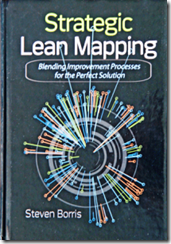When you think of mapping in Lean, your first thoughts are steered towards the tool of Value Stream Mapping. When I picked up the book, Strategic Lean Mapping, I had similar thoughts, another book on Value Stream Mapping. As I thumbed through the pages I found a very different approach. One that included Big Picture Map, Process Mapping, Capacity Mapping, Value-Stream Mapping, and closing with how to use this information for better problem solving and decision making. I found Steven Borris use of mapping quite different. However, the tools within the maps were quite common for a Lean Practitioner. 
Steve has worked with SMAS, a Scottish government agency tasked with improving the efficiencies of companies. He is a manufacturing advisor and continuous improvement expert and does this at Productivity Jigsaw. This is an excerpt from our podcast next week.
Joe Dager: We look at the individual processes and then I think you jumped into a Capacity Map which I really haven’t heard of before I read your book.
Steven Borris: Now the capacity map is my own. I was doing some work in a recycling plant, I had a colleague with me, we had a team of people that we were trying to train and what we did was we finally got the guys to do the process and there were 10 steps in the process. We put the process up on the wall, and we couldn’t see anything wrong with it. It was really weird. We knew the system wasn’t working efficiently, but we had no idea why. And basically what was happening was trucks were coming in with the materials. I can’t tell you what material is it, in case you can work out what the company was, but the materials were coming in and they were being loaded into a kind of pit and then the pit would take them to a conveyor belt and into a baler and they were only getting maybe eight bales, sometimes instead of maybe 30 that they could make.
When I was looking at this, they had four different ways that the materials came in and when I was staring at the wall map, I saw something and this is really stupid it may sound but I used to do electronics when I was younger, I used to work as an engineer and I saw what we call an operational amplifier circuit and I actually saw it in my mind. I know perhaps, I used to call them 741’s because you feed a signal like from an amplifier, and you get an output; it’s that simple. It’s just a single chip amplifier. But basically what that does is there’s a maximum gain you can get out of it and that maximum gain would be the maximum throughput of the baler. Then I working out what was causing the inputs to disappear and suddenly I saw a capacity problem. Basically, what was happening was if you got in an 18-wheeler truck, you could get the machine running non-stop and get 20 to 30 bales an hour. But then suddenly these little white Ford transits would come in from a local shop or something and they would start to unload their stuff and you can only do four vans in an hour, so suddenly you were down to maybe six or eight bales an hour and everything would just halt.
Suddenly the capacity became an issue, and that’s when I started to look at this idea of the capacity map. It’s also like to the theory of constraints. Once I had a map, I started to use it for other companies. Basically there was a company that made doors and when we laid out the entire process, exactly just using the process map, it suddenly dawned to me that what I could do is I could look at every machine, find out what it should be able to make and what they were making. If you take the ratio of what they do make to what they should make, that should get the OEE of the machine, so that was the capacity. You could literally look at the flow of the product going through it and see when it was easy to feed out when there was going to be a bottleneck. That will tell you from the beginning you need two machines instead of one in parallel. It just worked beautifully and all I had to do was when I had the process map steps laid out with the yellow post-its, I just had to write what they were doing and what they should be doing in another post-it and stack it above. It was that simple, and suddenly the whole horizon opened up. We were able to make some huge gains in productivity and it was probably as easy as the original goal when Eliyahu Goldratt wrote it and basically it was probably analogous to the scout troop walking through the line and getting the slowest guy to walk first. It’s that kind of simple if you just look at it.
From that map, I also did a bar chart and again it’s so easy because it’s just a histogram and the smaller the height of the bar chart…Imagine like limbo dancers, the harder it is to get the stuff through it. So if you’ve got a big bar chart leading into your little one, you can’t get the machine to cope with it so you got to start controlling the flow so that you’re making sure that you’re not overlooking the bottlenecks. So that was one, as I said that I just made up by myself.
Lean Sales and Marketing: Learn about using CAP-Do
